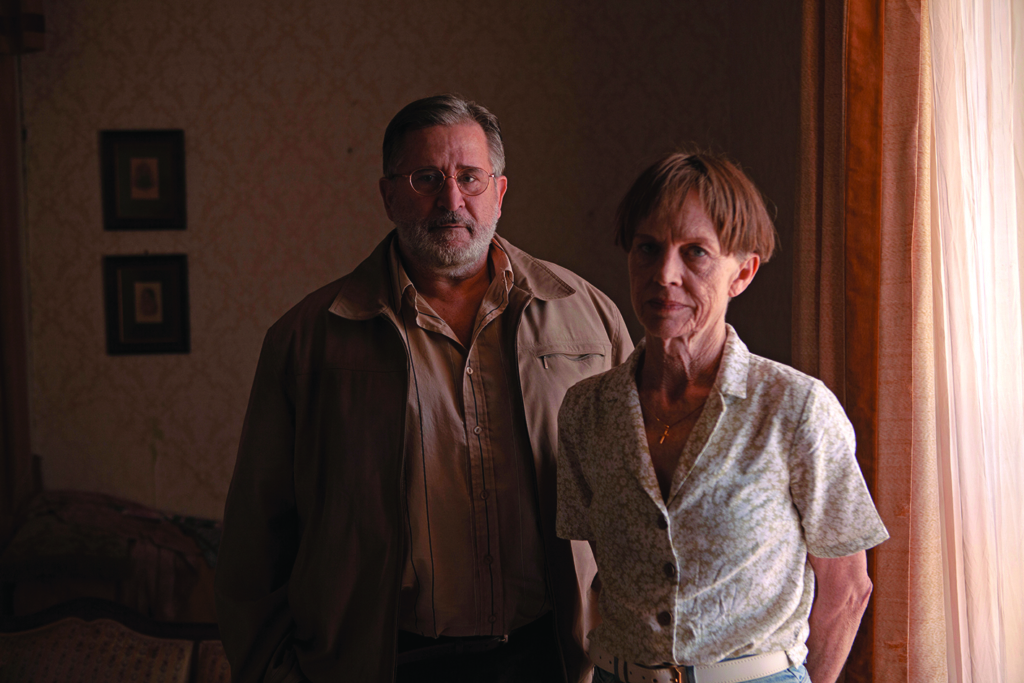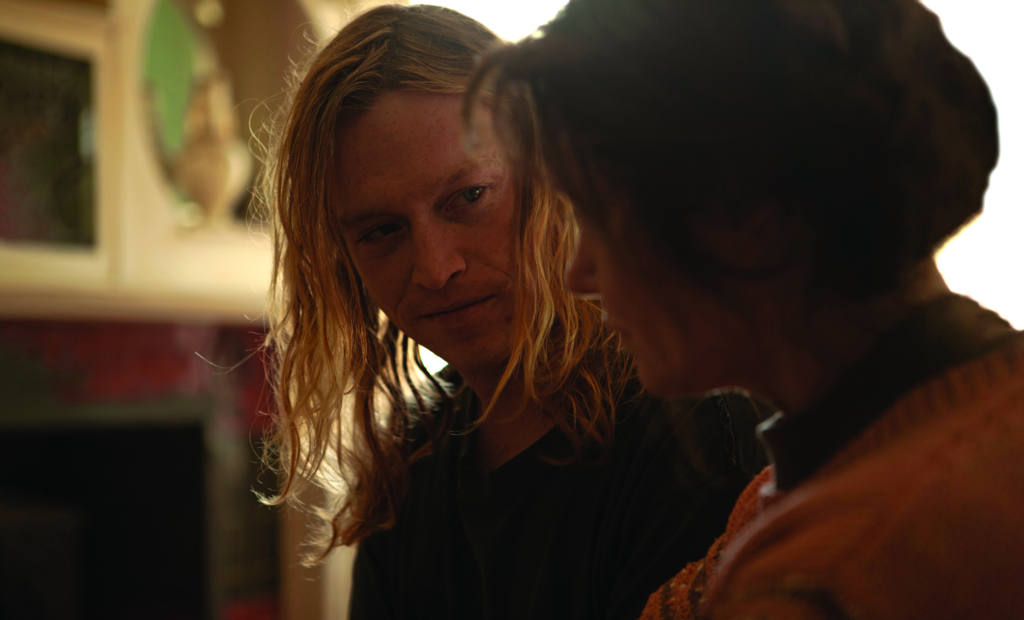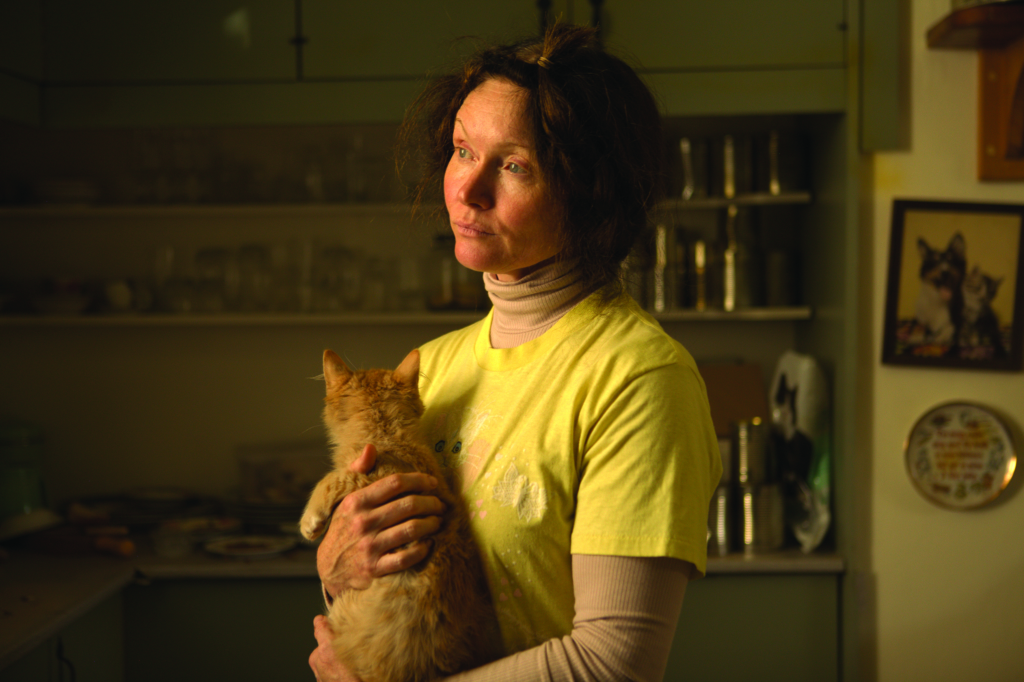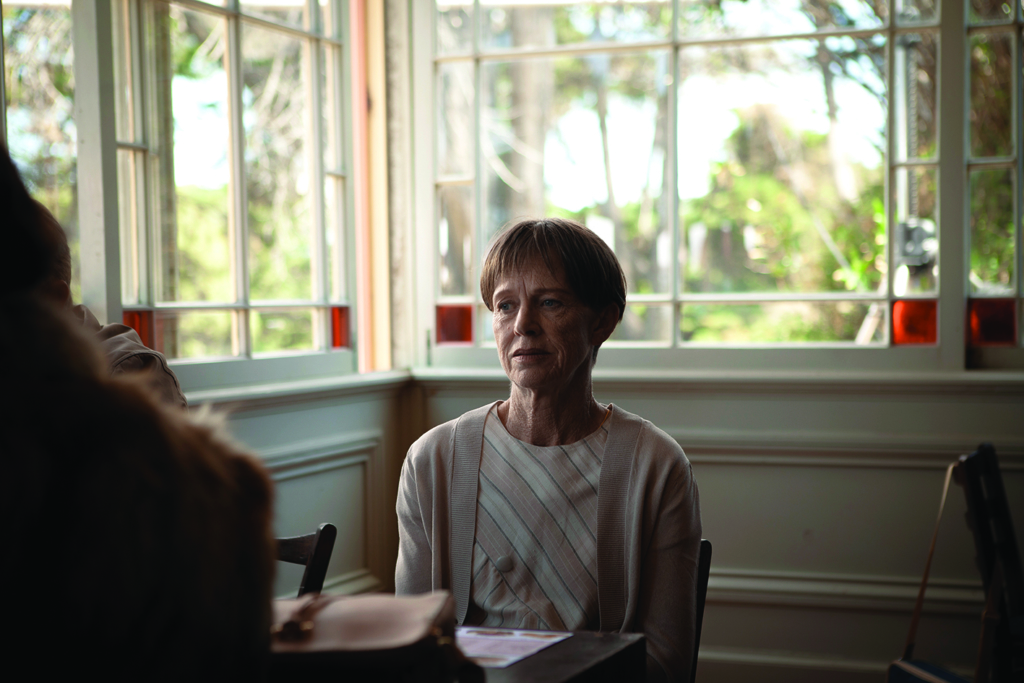In July 2018, Australian screenwriter Shaun Grant was living in Los Angeles. One day, his wife was planning to go down to their local supermarket when she was unexpectedly called in to work. It was a fateful change of plans: the supermarket was soon the site of a hostage situation in which shots were fired and one employee died.[1]See Robin Abcarian, ‘Must Reads: The Tender, Terrifying Truth About What Happened Inside the Trader Joe’s Hostage Siege’, Los Angeles Times, 3 August 2018, <https://www.latimes.com/local/la-me-abcarian-hostage-20180803-story.html>, accessed 20 October 2021. Any Australian expat in the US knows they’re inhabiting a completely different firearms climate (there were 336 mass shootings in the country in 2018 alone[2]See ‘Past Summary Ledgers’, Gun Violence Archive website, <https://www.gunviolencearchive.org/past-tolls>, accessed 20 October 2021.), but having such an incident occur so close to home became a catalysing incident for Grant. ‘I was surrounded by gun violence that I never saw in Australia,’ he offers. And, when his mind turned to why, it naturally settled on Port Arthur.
On 28–29 April 1996, in the Tasmanian historic former-penal-colony site, Martin Bryant murdered thirty-five people and wounded twenty-three more. It was by far the worst mass shooting in modern Australian history, and the deadliest massacre ever carried out on these shores by an individual.[3]See Jason Thomas & Madeleine King, ‘Port Arthur Interactive: The Events of That Day, and Their Lasting Impacts on Australian Society’, SBS News, updated 28 April 2016, <https://www.sbs.com.au/news/port-arthur-interactive-the-events-of-that-day-and-their-lasting-impact-on-australian-society>, accessed 21 October 2021. As Grant recalls, ‘We saw the best and worst of our nation within twelve days’: the tragedy of the massacre led to wideranging gun reforms, including a famous federal government buyback scheme, in which 643,000 privately owned firearms were handed over to authorities for destruction.[4]See Calla Wahlquist, ‘It Took One Massacre: How Australia Embraced Gun Control After Port Arthur’, The Guardian, 15 March 2016, <https://www.theguardian.com/world/2016/mar/15/it-took-one-massacre-how-australia-made-gun-control-happen-after-port-arthur>; and Simon Chapman & Philip Alpers, ‘A Safer Place After Howard’s Gun Buyback’, The Age, 28 April 2006, <https://www.theage.com.au/national/a-safer-place-after-howards-gun-buyback-20060428-ge27ir.html>, both accessed 25 October 2021. Wanting to author a defiant ‘anti-gun’ film, Grant began researching Bryant’s story and its greater cultural effects (with mass shootings in Christchurch and Nova Scotia occurring as he wrote, adding to the story’s tragic contemporary relevance). He was horrified to find that much of the legislation proposed during the 1996 reforms has never been passed, and that there is political agitation for further softening of gun laws.[5]See Joel Negin, ‘Port Arthur and Gun Control: We Cannot Rest on Our Laurels’, The Sydney Morning Herald, 28 April 2021, <https://www.smh.com.au/national/port-arthur-and-gun-control-we-cannot-rest-on-our-laurels-20210426-p57ml7.html>, accessed 21 October 2021.

This is the cultural moment into which Nitram (Justin Kurzel, 2021), the film that Grant wrote in response, has entered. Chronicling the lead-up to the Port Arthur massacre, its aim is to foster conversation about Australian firearm legislation by tackling one of the darkest incidents in the country’s recent history. When director Kurzel first received the screenplay, he admits to being ‘pretty scared’ and ‘very nervous’ about opening it up; but he recounts being gripped by its power, the facts of legal rollbacks that he didn’t know had occurred and the urgency of its messages. ‘[The screenplay] probably spoke to me more about gun reform than any conversation or discussion I’ve had,’ Kurzel says. ‘That’s what film can do, what arts can do: they can tap into a kind of truth that’s very different from reading a debate or an argument.’
Nitram has been regarded as ‘controversial’ in Australia, from the announcement of its production through to its 2021 premiere at Cannes and its eventual cinematic release in Australia – the question often being asked whether the film should even have been made.
Writing the script, Grant had been guided only by his ‘own moral compass’ and ‘belief in what [he] was doing’. Receiving it, Kurzel weighed up ‘the sensitivity of making a film about these events’; he recalls wondering, ‘How do you tread carefully? How do you try to do it in the best possible way, that’s respectful but feels like you’re still doing something that’s genuine?’ Kurzel ultimately settled on the idea that there was ‘a message’ in the film ‘that needed to be told’. For the 47-year-old filmmaker, the subject matter was also close to home. Kurzel met his future wife, actress Essie Davis, at the National Institute of Dramatic Art in Sydney in 1996, mere months before the Port Arthur massacre. Davis was born and raised in Hobart, and the couple relocated to Tasmania in 2017. ‘I’ve been very aware just how much it changed forever, this place,’ Kurzel says of the state in the wake of the tragedy. ‘The wound is still very, very deep. And it’s very difficult for people to talk about it. So, for them to engage with a film about the lead-up to that day […] was going to be incredibly sensitive.’

In turn, Nitram has been regarded as ‘controversial’ in Australia, from the announcement of its production[6]See, for example, Richard Bryant, ‘Is It Wrong to Make a Film About the Port Arthur Massacre? A Trauma Expert’s Perspective’, The Conversation, 2 December 2020, <https://theconversation.com/is-it-wrong-to-make-a-film-about-the-port-arthur-massacre-a-trauma-experts-perspective-151277>, accessed 21 October 2021. through to its 2021 premiere at Cannes and eventual cinematic release in Australia – the question often being asked whether the film should even have been made,[7]See Patrick Frater, ‘Cannes Selection of Justin Kurzel’s Nitram to Reopen Violence Debate’, Variety, 3 June 2021, <https://variety.com/2021/film/asia/cannes-justin-kurzel-nitram-violence-australia-shooting-1234987776/>; and ‘“Scared to Look Us in the Eye”: Port Arthur Survivor Slams New Film’, Mercury, 14 October 2021, <https://www.themercury.com.au/news/tasmania/nitram-writer-and-director-open-up-about-port-arthur-film/news-story/f479da2c31640c3fdc03672c014f4a6c>, both accessed 21 October 2021. and government funding bodies on state and national levels declining to offer production assistance.[8]See Stephen A Russell, ‘Dark History: Justin Kurzel and Shaun Grant on Retracing the Road to Port Arthur in Nitram’, SBS Movies, 30 September 2021, <https://www.sbs.com.au/movies/article/2021/09/27/dark-history-justin-kurzel-and-shaun-grant-retracing-road-port-arthur-nitram>, accessed 28 October 2021. ‘I think it’s important that artists feel the ability to be able to tell stories about hard stuff, and that they’re given an element of mercy when exploring them,’ Kurzel says. ‘If we’re getting to a stage where we’re not allowed to – or we feel scared to even attempt to – put a lens on challenging material, I don’t know whether that’s very healthy.’ The director – referring to Nitram, his greater filmography and art in a broader sense – speaks about how cinema facilitates discussion, his simple edict being ‘that there’s allowed to be a conversation’.
Though it’s a fictionalised narrative of Bryant’s life in the years leading up to the incident at Port Arthur, Nitram begins with a shocking, unexpected piece of reality: newsreel footage of the real-life Bryant, at age eleven, being interviewed in the burns unit of the Royal Hobart Hospital. He’s been burnt from a mishap that occurred when playing with firecrackers, but when the posh-voiced reporter asks if he’s going to stop now, the young Bryant retorts that he won’t. From that we cut to the film’s present, where Nitram[9]This nickname is – like the film’s title – pronounced ‘knit-ram’, with emphasis on both syllables. (as the character is called, intermittently, as a mocking schoolyard taunt – Bryant’s real name is never uttered), played by Caleb Landry Jones, is now in his mid twenties and still playing with firecrackers, annoying neighbours and entertaining primary school kids with the detonations.

He’s a manchild, in an unnerving way. When we see Nitram browbeaten by his overbearing mother (Judy Davis), sulking or riding on playground swings, there’s a sense of foreboding, given Bryant was found to have the equivalent intelligence of an eleven-year-old – ‘borderline intellectually disabled’ – at his criminal hearing.[10]‘Shedding Light on Port Arthur Killer’, The Age, 29 March 2006, <https://www.theage.com.au/national/shedding-light-on-port-arthur-killer-20060329-ge218p.html>, accessed 21 October 2021. It’s believed Bryant also had undiagnosed autism,[11]He was subsequently diagnosed with Asperger’s syndrome in prison. See ‘Bryant’s Mother Defends Her Son’, SBS News, 24 February 2015, <https://www.sbs.com.au/news/bryant-s-mother-defends-her-son>, accessed 21 October 2021. and the onscreen depiction (as scripted by Grant and acted by Jones, who won the Best Actor award at the 2021 Cannes Film Festival for his performance) is consistent with that notion. The medical care he did receive is indicted in a scene at the office of an ineffectual doctor (Conrad Brandt), who doles out antidepressants and a medical certificate for the family to keep receiving a disability pension, but fails to provide any real understanding or aid. There’s prime dysfunction in the family unit, too: on either side of the wild child is a parent respectively too critical (his mother) or too lenient (his father, a feeble figure played by Anthony LaPaglia). But there’s also a surprising domestic quality to Nitram’s opening psychological study, with the film’s first act effectively about the difficulties of parenting a child with serious developmental issues.
‘A large part of the film is the struggles of parents dealing with challenging individuals,’ Grant says; the archival footage on opening testifies to the fact that these parents have ‘struggled with this child for his entire life’. Kurzel says that, through this beginning, Nitram is asking ‘questions about parenting that we all think about’: not just, as the director puts it, ‘How do you love someone who every day is making your life as difficult as they can?’ but also about a parent’s sense of responsibility in how their offspring turn out. While neither parent character (billed simply as ‘Mum’ and ‘Dad’ in the credits) is presented particularly sympathetically, there’s real empathy here for them in how abandoned they are by their community – by a society that labels their child a ‘retard’, by the brutal misunderstandings of mental health treatment that ruled in suburban Australia in the 1980s and 1990s. In this way, the rise of this monster is a failing of the society that birthed him; his parents may be at the front line of that failure, but they are hardly the most complicit. ‘[Nitram is] a conversation about isolation and about mental illness, and how we treat those people that are making really bad choices,’ Kurzel says.

Nitram’s world is largely insular due to his self-obsession and socially maladroit ways. When he goes down to the beach to watch the surfers, he’s standing on the outside of Australia’s mainstream sporting culture – a wayward loner who can’t connect with peers. An unlikely connection is forged when he stumbles into the life of Helen (Essie Davis) – based on Helen Harvey, a real-life friend of Bryant’s[12]See Robert Wainwright & Paola Totaro, ‘A Dangerous Mind: What Turned Martin Bryant into a Mass Murderer?’, The Sydney Morning Herald, 27 April 2009, <https://www.smh.com.au/national/a-dangerous-mind-what-turned-martin-bryant-into-a-mass-murderer-20090427-ajo6.html>, accessed 21 October 2021. – another disturbingly childlike figure (though she is deep into middle age, her braces signify her emotional immaturity). Her minor musical-theatre celebrity having long since waned, Helen is an eccentric heiress who lives alone in an inherited family home that’s huge, imposing, falling to ruin. She, too, is detached from reality, living among her dogs, memories and delusions, playing the same old screen musicals and Gilbert and Sullivan stage recordings over and over. Soon after they meet, Nitram moves into her house, another step in the film’s slow, steady descent into darkness: not only is he removed from his family unit, from something approaching stability and support, but he’s now living with someone who enables many of his most hazardous behaviours and finds delight in his impulsive acts. ‘Sorry, he’s just excited,’ she shakes her head in tepid apology when Nitram dangerously yanks the steering wheel of a moving car; ‘Helen gives me whatever I want,’ he boasts in another sequence, mockingly, to his parents.
After this odd-couple-sitcom set-up provides some brief levity – set to madcap songs from H.M.S. Pinafore – twin tragedies strike, sending Nitram into a full-blown downward spiral. Firstly, Helen dies in a car accident for which he is responsible (the steering-wheel yanking played first as comedy, then as tragedy); and then his father, despondent after failing to secure the purchase of a coastal property he was hoping to turn into a historical tourist site, is found dead, by suicide, in a dam. With the two people he’s closest to suddenly gone (although Nitram tells his mother that he doesn’t miss his father, and that he wasn’t sad when he died), we see a reeling figure, one whose isolation and dislocation from reality are amplified by the fact that Helen has left him her house and fortune. Now this unhinged, untreated individual – who we know has an affinity for firecrackers and air rifles – has the means to buy whatever he wants, and no-one to curb his most dangerous impulses. Two acts into Nitram, things take their final turn; the subsequent horror comes not in the (off-screen) moments when the lead character opens fire on people, but in the ease with which he buys his cache of weapons.

Grant thought that the ‘strongest’ and ‘most powerful’ way to tell this contemporary tragedy was ‘to place the audience in the shoes of someone who should not be anywhere near military-style weapons [for] seventy or eighty minutes […] then walk into a gun shop and see how easy it is for them to obtain these things.’ When Kurzel read the script, that was the moment that grabbed him. ‘Shaun had created this recognisable world where you got to watch and observe an individual [who] started to become more isolated, and started to make some erratic decisions,’ he offers, ‘and just at that moment when they’re at their most dangerous, they […] start buying guns like fishing rods.’
The scene is gripping, effectively inducing a feeling of dread. The gun shop owner (Rick James), while giving a few basic safety tips and lessons, is an aggressive salesman; the fact that Nitram doesn’t have a gun licence merely means they’ll have to sell him assault weapons unregistered. When we head from the commercial shopfront into the backroom warehouse – though ‘bunker’ seems a more apt descriptor – it’s a down-the-rabbit-hole moment, Nitram entering a dark gun culture that will lead to national tragedy.
The inciting incident that leads him from being an ‘enthusiast’ to a mass murderer is drawn from reality: it’s believed that Bryant saw news coverage of the Dunblane massacre, a school shooting in rural Scotland that occurred months before Port Arthur,[13]See Meilan Solly, ‘How the 1996 Dunblane Massacre Pushed the U.K. to Enact Stricter Gun Laws’, Smithsonian Magazine, 12 March 2021, <https://www.smithsonianmag.com/history/how-1996-dunblane-massacre-pushed-uk-enact-stricter-gun-laws-180977221/>, accessed 21 October 2021. and took it as inspiration. As we hear the news report profile the Scottish killer (‘well known to police and locals’, he was ‘a misfit, a loner, an oddball, a weirdo […] mistrusted for his obsession with young boys, and with guns’), the effect is eerie. Grant connects this narrative foreshadowing to the similarities seen among perpetrators of mass shootings: ‘anger management issues, trouble at school, absence or loss of a father figure’. Examining these individuals, he says, is a response to the recurring nature of these tragedies. ‘If it wasn’t continually happening, the film wouldn’t need to exist,’ he says. ‘Because [these shootings] continue to come about, I felt it was important to examine why and how.’

Yet, by showing its central figure witnessing a news report on Dunblane, Nitram also evokes the spectre of the copycat effect – something that critics of this film, and of films like it, cite as the dangerous results of depicting violent atrocities. They point, too, to the fact that breathless news coverage – and perhaps even the most artful art-movie retelling of events – offers perpetrators the notoriety they crave. But the filmmakers, who shy away from depicting any death on screen, see the film as having a bigger purpose, a larger contemporary meaning. Like 2011’s Snowtown (based on a series of murders in South Australia in the 1990s)[14]See Alexandra Heller-Nicholas, ‘Homegrown Horror: The Ethics of Snowtown’s Suburban Nightmare’, Metro, no. 169, 2011, pp. 14–9. and 2019’s True History of the Kelly Gang (a colourful riff on the mythos of Australia’s favourite murderous folk hero)[15]See Alexandra Heller-Nicholas, ‘The Pen Is Mightier than the Gun: Justin Kurzel’s True History of the Kelly Gang and Punk Historiography’, Metro, no. 203, 2020, pp. 6–13. – both also scripted by Grant and directed by Kurzel – Nitram is an exploration of Australian violence and masculinity rooted in the failure or fragmentation of the family unit. (‘All three films, there’s a lot to do with parenting,’ Grant considers. ‘All protagonists have either lost or lose their father [just as] both Justin and I have lost our own fathers.’) These three films, Kurzel says, poke at the ‘uncomfortable relationship’ Australia has with its violent history. ‘[We have a resistance to] talking about brutal times, our brutal history. I think that goes way, way, way back – to how we talk about genocide, especially here in Tasmania,’ he notes. ‘I’ve always found it curious as to why we’re not having conversations about those times, about those pretty dark chapters.’
Snowtown, True History of the Kelly Gang and Nitram each, to their makers, seek to ‘question why’ violence occurs and explore how it’s often the product of a violent society. But Nitram has a more pointed, more polemical quality to it – the film’s existence is an agitation for further gun reform. Its screenwritten roots in the US suggest a hope that it can play into that nation’s dire conversation about firearms, but there’s far more local specificity in its subtext, in the questions the film’s makers hope to raise and the conversation they hope to foster. ‘Where are we [in Australia] in our discussions and conversations about gun reform?’ Kurzel wonders. ‘Why are we now having discussions about softening those regulations?’ In interview, the director leaves these questions to linger; at the end of Nitram, the sad facts are similarly left hanging, the film’s closing intertitles conveying a host of chilling facts. There’s the numbered dead and wounded, of course, the unnamed victims of its unnamed titular character. But then there’s the final card, which reads, simply and solemnly: ‘No State or Territory has been fully compliant with the National Firearms Agreement. There are now more firearms owned in Australia than in 1996.’
Endnotes
| 1 | See Robin Abcarian, ‘Must Reads: The Tender, Terrifying Truth About What Happened Inside the Trader Joe’s Hostage Siege’, Los Angeles Times, 3 August 2018, <https://www.latimes.com/local/la-me-abcarian-hostage-20180803-story.html>, accessed 20 October 2021. |
|---|---|
| 2 | See ‘Past Summary Ledgers’, Gun Violence Archive website, <https://www.gunviolencearchive.org/past-tolls>, accessed 20 October 2021. |
| 3 | See Jason Thomas & Madeleine King, ‘Port Arthur Interactive: The Events of That Day, and Their Lasting Impacts on Australian Society’, SBS News, updated 28 April 2016, <https://www.sbs.com.au/news/port-arthur-interactive-the-events-of-that-day-and-their-lasting-impact-on-australian-society>, accessed 21 October 2021. |
| 4 | See Calla Wahlquist, ‘It Took One Massacre: How Australia Embraced Gun Control After Port Arthur’, The Guardian, 15 March 2016, <https://www.theguardian.com/world/2016/mar/15/it-took-one-massacre-how-australia-made-gun-control-happen-after-port-arthur>; and Simon Chapman & Philip Alpers, ‘A Safer Place After Howard’s Gun Buyback’, The Age, 28 April 2006, <https://www.theage.com.au/national/a-safer-place-after-howards-gun-buyback-20060428-ge27ir.html>, both accessed 25 October 2021. |
| 5 | See Joel Negin, ‘Port Arthur and Gun Control: We Cannot Rest on Our Laurels’, The Sydney Morning Herald, 28 April 2021, <https://www.smh.com.au/national/port-arthur-and-gun-control-we-cannot-rest-on-our-laurels-20210426-p57ml7.html>, accessed 21 October 2021. |
| 6 | See, for example, Richard Bryant, ‘Is It Wrong to Make a Film About the Port Arthur Massacre? A Trauma Expert’s Perspective’, The Conversation, 2 December 2020, <https://theconversation.com/is-it-wrong-to-make-a-film-about-the-port-arthur-massacre-a-trauma-experts-perspective-151277>, accessed 21 October 2021. |
| 7 | See Patrick Frater, ‘Cannes Selection of Justin Kurzel’s Nitram to Reopen Violence Debate’, Variety, 3 June 2021, <https://variety.com/2021/film/asia/cannes-justin-kurzel-nitram-violence-australia-shooting-1234987776/>; and ‘“Scared to Look Us in the Eye”: Port Arthur Survivor Slams New Film’, Mercury, 14 October 2021, <https://www.themercury.com.au/news/tasmania/nitram-writer-and-director-open-up-about-port-arthur-film/news-story/f479da2c31640c3fdc03672c014f4a6c>, both accessed 21 October 2021. |
| 8 | See Stephen A Russell, ‘Dark History: Justin Kurzel and Shaun Grant on Retracing the Road to Port Arthur in Nitram’, SBS Movies, 30 September 2021, <https://www.sbs.com.au/movies/article/2021/09/27/dark-history-justin-kurzel-and-shaun-grant-retracing-road-port-arthur-nitram>, accessed 28 October 2021. |
| 9 | This nickname is – like the film’s title – pronounced ‘knit-ram’, with emphasis on both syllables. |
| 10 | ‘Shedding Light on Port Arthur Killer’, The Age, 29 March 2006, <https://www.theage.com.au/national/shedding-light-on-port-arthur-killer-20060329-ge218p.html>, accessed 21 October 2021. |
| 11 | He was subsequently diagnosed with Asperger’s syndrome in prison. See ‘Bryant’s Mother Defends Her Son’, SBS News, 24 February 2015, <https://www.sbs.com.au/news/bryant-s-mother-defends-her-son>, accessed 21 October 2021. |
| 12 | See Robert Wainwright & Paola Totaro, ‘A Dangerous Mind: What Turned Martin Bryant into a Mass Murderer?’, The Sydney Morning Herald, 27 April 2009, <https://www.smh.com.au/national/a-dangerous-mind-what-turned-martin-bryant-into-a-mass-murderer-20090427-ajo6.html>, accessed 21 October 2021. |
| 13 | See Meilan Solly, ‘How the 1996 Dunblane Massacre Pushed the U.K. to Enact Stricter Gun Laws’, Smithsonian Magazine, 12 March 2021, <https://www.smithsonianmag.com/history/how-1996-dunblane-massacre-pushed-uk-enact-stricter-gun-laws-180977221/>, accessed 21 October 2021. |
| 14 | See Alexandra Heller-Nicholas, ‘Homegrown Horror: The Ethics of Snowtown’s Suburban Nightmare’, Metro, no. 169, 2011, pp. 14–9. |
| 15 | See Alexandra Heller-Nicholas, ‘The Pen Is Mightier than the Gun: Justin Kurzel’s True History of the Kelly Gang and Punk Historiography’, Metro, no. 203, 2020, pp. 6–13. |





